First of all, he’s not some impossibly strong, hard-to-kill monster. He’s a dying cancer patient. In Saw II, he needs oxygen to carry out a conversation at his kitchen table. In Saw III, he’s completely bedridden, minutes from death. (The filmmakers do a great job making him unsettling precisely because he’s so weak and frail. He looks half-dead already.)
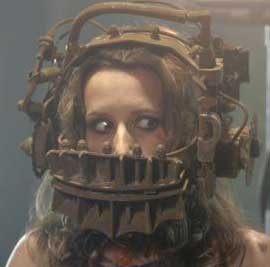
A tetanus shot is the least of her problems.
What makes Jigsaw something to be feared are the “traps” he puts his victims in (with the aid of apprentices, hired thugs, and people who are forced to set up other traps in order to escape their own). The original, titular trap is fiendishly simple. You are chained to the wall and given a saw. The saw is not sharp enough to cut the chains. It is, however, sharp enough to chop off a foot. “How much blood will you shed to stay alive?” Jigsaw likes to ask his victims. In later movies, the traps range from sadistically simple (a cop is told to reach into a beaker of acid to retrieve the key that can save her life) to goofy symbolic (a drug dealer is told to dive into a pit of hypodermic needles to retrieve the key can save his life) to needlessly complex (a carousel executes its six riders one at a time, but an observer is permitted to save exactly two by drilling holes in his hands). The series doesn’t have much humor, but at one point there’s a throwaway shot of Jigsaw on the cover of Civil Engineering magazine.
So Jigsaw is a guy who likes to inflict pain, right? Nope. He doesn’t take any pleasure in his traps. In fact, he genuinely doesn’t want to anyone to die. “Technically speaking,” Cary Elwes explains in the first film, “he’s not really a murderer. He never killed anyone.” But he knows from his own terminal cancer and failed suicide attempt that confronting pain and death is the only true way to make someone appreciate life. The people who perish in his traps just didn’t value their life enough to fight for it, and were therefore unworthy of it. “Most people are so ungrateful to be alive,” he tells a survivor. “But not you. Not anymore.”

And in this corner, weighing 107 pounds…
I would bet serious money that one of the inspirations for Saw was Fight Club (1999). At one point, Tyler Durden points a gun at the night clerk of a convenience store, drags him out back, and declares, “Raymond! You’re going to die.” He interrogates poor Raymond and learns that his dream was to become a veterinarian, but it was too hard. “I know where you live,” Tyler says. “If you’re not working to be a veterinarian in six weeks, you will be dead.” He lets Raymond go, and then muses, “Tomorrow will be the most beautiful day of Raymond K Hessel’s life. His breakfast will taste better than any meal you and I have ever tasted.”
Jigsaw is Tyler Durden, without the abs or the sense of humor. He sees his traps as acts of mercy. He doesn’t want to hurt these people. He wants them to stop being crooked cops, loan sharks, philandering husbands, drug dealers, etc. He may put you in a death trap, but he is rooting for you to escape. Jigsaw believes that those who survive will be cured of their vices and redeemed through their suffering. (There’s something very medieval about these purification rituals, and I don’t think it’s a coincidence that he’s often seen in a hooded robe, like a monk.)
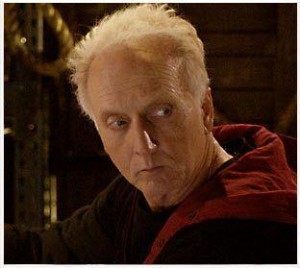 Jigsaw sometimes refers to the traps as “games,” but he also calls them “tests,” and the people inside them “subjects.” In other words, he’s performing experiments. He’s an engineer by training, and he sees the people he selects as defective machines in need of repair. Once upon a time, he worked with his ex-wife at a health clinic to heal people the old fashioned way. But fighting addiction and changing patterns of negative behavior is a grueling, uphill battle. John Kramer was determined to find a quick fix for a broken soul.
Jigsaw sometimes refers to the traps as “games,” but he also calls them “tests,” and the people inside them “subjects.” In other words, he’s performing experiments. He’s an engineer by training, and he sees the people he selects as defective machines in need of repair. Once upon a time, he worked with his ex-wife at a health clinic to heal people the old fashioned way. But fighting addiction and changing patterns of negative behavior is a grueling, uphill battle. John Kramer was determined to find a quick fix for a broken soul.
In other words, Jigsaw’s games are Star Trek solutions to Babylon 5 problems. “You and your wife don’t talk anymore? I bet I can design a machine for that.”
What fascinates me is, even after six films, there is little or no evidence that Jigsaw’s traps actually “fix” anyone. First of all, the number of people who survive is vanishingly small. Here are the movies in which the main person being tested loses their “game”: Saw I, Saw II, Saw III, Saw IV, and Saw VI. Saw V is the only film in which the some of the characters actually “win” the movie’s central test. And even then, these guys only survive the hard way, through massive bloodshed, as opposed to the easy way, simple teamwork.
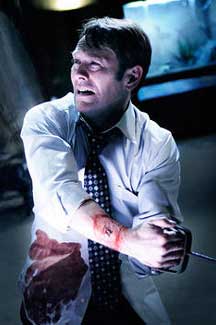
When this is all over, you’ll thank me. Unless, of course, you are injected with gallons of hydrochloric acid.
The only person we ever see Jigsaw successfully “rehabilitate” is Amanda Young… and it turns out in Saw III that she never really changed at all. “Nobody changes,” she screams in her final moments. “Nobody is reborn. It’s all a lie.” In Saw VI, Detective Hoffman talks to a woman who survived by hacking off her own arm. “We were ruining people’s lives,” she admits, “And he wanted us to learn.” Hoffman, who had secretly set up the trap, can’t resist asking her, “And did you?” She blows up in his face: “Look at my arm! What am I supposed to learn from this?” She may decide to change careers, but she doesn’t seem particularly grateful to have been tested.
So the jury’s still out. Are the movies suggesting that Jigsaw is wrong, and that these traps bring nothing but death and misery? Or do the movies pretty much buy into Jigsaw’s theory of rehibilitation, but the filmmakers find it too much fun to kill off everybody instead of allowing them to go back to night school and become veterinarians? I’m actually inclined to believe the later. Jigsaw is always presented as possessing a nearly superhuman intellect. He somehow knows every detail about his victim’s lives, even secrets he has no way of knowing. He designs intricate, escape-proof traps that always operate flawlessly. He anticipates every possible outcome, leaving an endless supply of little tape recorders one step ahead of the police officers chasing him. This character isn’t supposed to be some deluded fool who doesn’t realize how pointless his actions are. He’s supposed to be the ubermensch.
You would think that by the seventh film, the series would have nowhere to go. But in what’s being billed as “the final chapter,” the filmmakers are actually just getting around to the burning question: is Jigsaw a deluded murderer, or a bold visionary? Check out the IMDB summary of Saw 3D:
As a deadly battle rages over Jigsaw’s brutal legacy, a group of Jigsaw survivors gathers to seek the support of self-help guru and fellow survivor Bobby Dagen, a man whose own dark secrets unleash a new wave of terror.
Finally, we’re going to focus on the people Jigsaw thinks he “saved.” They are the ultimate referendum on his actions: if they have been granted a new appreciation for life, than Jigsaw was right (by his own reckoning, at least). But if these survivors are shattered husks of their former selves, he was wrong.
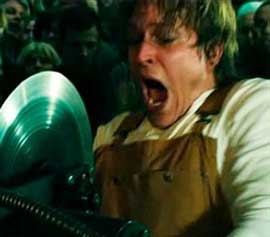
A prediction: stuff will come flying at us in 3D. Sharp stuff.
But that’s not really what Saw 3D will be about.
Jigsaw’s master plan has never been a secret. “What is the cure for cancer?” he asks Detective Matthews in Saw II. At the end of the film, Amanda Young answers for him, “By creating a legacy, by living a life worth remembering, you become immortal.” In Saw IV, he leaves a tape from beyond the grave: “By hearing this tape, some will assume that this is over but I am still among you. You think it’s over just because I am dead. It’s not over. The games have just begun.” What does it add up to? Jigsaw isn’t merely out to test as many people as he can before he dies. He’s out to make sure the tests continue after he dies. The survivors aren’t his legacy; the traps are. As long as they continue, he’s achieved his immortality.
This is what the final chapter needs to be about: how does Jigsaw ensure that his work continues?
I have a couple theories. As Jigsaw was dying, his two apprentices fought for his approval like jealous children. Hoffman blackmailed Young, resulting in her death. But Jigsaw, somehow anticipating this, left posthumous instructions for his ex-wife Jill Tuck to kill Hoffman. She tries this at the end of Saw VI, but he escapes seemingly certain death. So now the two of them are presumably after each other, and Hoffman presumably has some gnarly facial scars. That rivalry will certainly be a subplot, but I’m betting they wipe each other out in the last act. Jigsaw’s legacy is bigger than either of them.
To find the starting point for Saw 3D, just consider the big loose end from Saw VI. When Jill Tuck opens the box Jigsaw left for her, she finds five envelopes for setting up a game involving the evil insurance company. She finds a sixth envelope, which tells her to kill Hoffman. Then there’s the seventh envelope. It’s bulky… videotape bulky. She is seen bringing it to a hospital and slipping it through a mail slot. A lot of speculation on Saw message boards says this is a tape for Dr. Gordon, but I don’t buy it. I’m pretty sure that Dr. Gordon never made it back to civilization. If he had, how come Adam was left to rot in the Bathroom of Doom? Don’t forget, Dr. Gordon actually failed his test, so Jigsaw isn’t going to let him walk away. The man is a stickler for the rules.
So who is the seventh envelope for? I’m going to guess Bobby Dagen, this mysterious Jigsaw survivor who has not been seen before. If he’s a self-help guru like the summary says, he might be a psychiatrist and have an office in a hospital. Perhaps Bobby Dagen was part of some trap towards the beginning of Jigsaw’s career, early enough so that Bobby could have already published a book about the experience by the time Jigsaw dies. Bobby is telling people that although he doesn’t condone Jigsaw’s brutal methods, having to face death and endure pain is a gift, because you never again take your life for granted. Jigsaw approves of this message, and realizes Bobby is the perfect vehicle to spread his legacy. Alternate theory: Bobby’s book is actually written by Jigsaw himself. Bobby was poisoned by Jigsaw, and he gets the antidote mailed to him every four weeks in exchange for being a secret mouthpiece.
Jigsaw’s final posthumous game, put into motion by that seventh envelope Jill Tuck delivers, is a game for Billy Dagen. The game involves broadcasting his message to a mass audience. See the official trailer for a hint of this. Every single trap in Saws I-VI took place in an abandoned building – someplace isolated. But look what’s happened here. The game is taking place in the middle of the city, in front of a huge crowd.
http://www.youtube.com/watch?v=nVQZIJr6z2g
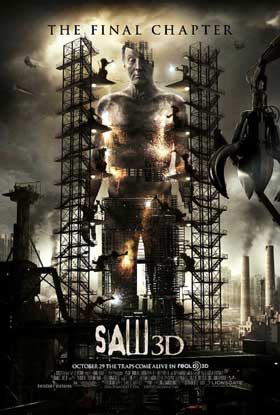 Jigsaw wants everyone to hear his message. And I’m guessing the message boils down to: “Shape up people, because if you’re not living a good life my disciples, who are out there living among you, watching, might bring you to an old abandoned warehouse and make you gouge out your own eyeball with a knitting needle.”
Jigsaw wants everyone to hear his message. And I’m guessing the message boils down to: “Shape up people, because if you’re not living a good life my disciples, who are out there living among you, watching, might bring you to an old abandoned warehouse and make you gouge out your own eyeball with a knitting needle.”
(Additional Saw 3D prediction based on the trailer: When he says, “The final piece of the puzzle… is you,” he’s speaking literally. Remember all those puzzle pieces he carved out of his victims? We’ll see them again.)
Take a look at the official poster for Saw 3D. It’s a giant statue of Jigsaw (shirtless for some reason) going up in an industrial wasteland. Either a) this image is completely meaningless and incredibly stupid, or b) Jigsaw is going to become the subject of a cult, elevated to legendary status in the public’s imagination. What’s the cure for cancer? Scaring everyone into living a better life, out of fear that they’ll wake up locked in one of your traps. That’s how the Saw series is going to end… with John Kramer’s legacy assured, and the door left open for endless sequels down the road. If they can stick the dismount this weekend, the boys at Twisted Pictures will have accomplished something unheard of: telling one big story over seven films in seven years. That, my friends, is twisted.
Update, 10/31/10:
I’ve seen Saw 3D, and grinned my way through the whole thing. I am now going to create a Google Alert for “Saw 8.” The thought of a Halloween without one of these is already depressing me.
That being said, I was largely wrong about my Saw 3D predictions, and I’m not sure I love how the meta-plot was wrapped up.
 First of all, the tape in Saw VI was, in fact, delivered to Dr. Gordon. I discounted this, because:
First of all, the tape in Saw VI was, in fact, delivered to Dr. Gordon. I discounted this, because:
- If Dr. Gordon was still alive, than Adam would have been found.
- Dr. Gordon technically lost his game, cutting off his foot AFTER the deadline, and failing to kill Adam as he was instructed. Based on everything we know about Jigsaw, he’s not going to get a pass for that.
The movie sidesteps #1 by explaining that Gordon was actually saved by Jigsaw and turned into an apprentice. But #2 is still a problem. In order for me to accept this revelation, I have to believe that Dr. Gordon was tested AGAIN, after he recovered from all the blood loss. If there is another sequel (please please) it will have to feature lots of flashbacks to Dr. Gordon’s relationship with Jigsaw, showing exactly how he was turned.
By the way, I love how the revelation about Dr. Gordon suddenly makes a lot of the old traps more plausible, since they would have required medical expertise. For instance, in Saw II, there was the guy with the key behind his eyeball. Nobody questioned the plausibility of this at the time, since you’ve just got to assume Jigsaw is impossibly clever at choreographing this stuff. But in retrospect, yeah, okay. It’s like how after Detective Hoffman was revealed to be an apprentice, Saw II suddenly makes more sense, since it requires knowing the secrets about how Eric Matthews was framing people for crimes. Jigsaw could never have know this, but Hoffman would have, obviously. Hell, in retrospect, the detectives should have been asking themselves, “Wait, how DOES Jigsaw know what he knows?”
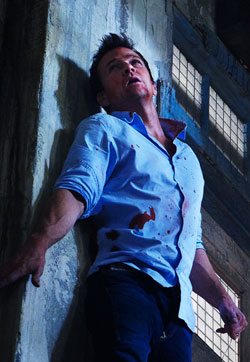 Then there’s Bobby. My girlfriend actually suggested last week that he was a big faker, and that he had never been in a trap. But I discounted this for a simple reason: no sane person would claim to have been tested by a still-active serial killer with a reputation for torturing people who piss him off. You are just BEGGING for him to come after you. It turns out that yes, Bobby is just that stupid.
Then there’s Bobby. My girlfriend actually suggested last week that he was a big faker, and that he had never been in a trap. But I discounted this for a simple reason: no sane person would claim to have been tested by a still-active serial killer with a reputation for torturing people who piss him off. You are just BEGGING for him to come after you. It turns out that yes, Bobby is just that stupid.
My big theory above, about the Cult of Jigsaw, didn’t QUITE happen, although there were nods to it. (At the end, Dr. Gordon goes after Hoffman with two accomplices. This is now officially Project Mayhem.) But then I wonder, what’s the deal with the opening trap, which takes place in public? My guess is an earlier draft made more use of this. No other trap, ever, has taken place in public – there’s got to be a reason. And nevermind that – how the hell did Dr. Gordon set that up? Who rested that space? Who rigged it? Why aren’t the police looking into it? And that brings me to…
Meet the new boss, same as the old boss? What kind of a Jigsaw is Dr. Gordon going to be? First of all, Carey Elwes absolutely pulls off the creepy – that final scene was just great. But let me point out a couple things he’s doing that Jigsaw wouldn’t:
- Not all his traps are fair. Bobby has no way to save his wife, which means that Gordon is straight-up murdering her. Jigsaw wouldn’t have done this.
- Dr. Gordon wipes out a whole SWAT team. Once again, Jigsaw was very clear about not directly killing people, and certainly people he wasn’t testing. I think Dr. Gordon is going to be a lot more comfortable with collateral damage than his mentor.
- Like I said, the trap unfolding in the public square must mean something. Either it’s Dr. Gordon’s idea, or Jigsaw left instructions to start raising the profile of these games. Either way, it’s something new.
Finally, this movie kind of punts on the Big Question of, “Do Jigsaw’s traps really help people?” In Bobby’s survivor group, one survivor feels empowered, while another seems disgusted with the very idea that anyone could be transformed by this experience. More disturbingly, it’s becoming clear that a large number of people who Jigsaw tests subsequently assist with the testing of others. In other words, being tested by Jigsaw may make you a “better” person, but it also makes you a psychopath.
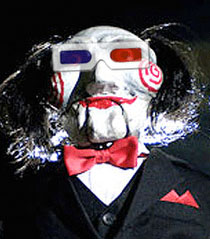 I’m now of the camp that Jigsaw’s traps don’t improve anyone’s life. We never see any Jigsaw survivor quitting their job to help the homeless, spend more time with their kids, or finish a novel. All that survivors seem to do is inflict pain on others. It’s a contagious disease. Jigsaw once described his work as being about rehabilitation, but I ain’t buying it. This is about punishment. He’s not helping these people; he’s just making them pay a horrible price for their sins.
I’m now of the camp that Jigsaw’s traps don’t improve anyone’s life. We never see any Jigsaw survivor quitting their job to help the homeless, spend more time with their kids, or finish a novel. All that survivors seem to do is inflict pain on others. It’s a contagious disease. Jigsaw once described his work as being about rehabilitation, but I ain’t buying it. This is about punishment. He’s not helping these people; he’s just making them pay a horrible price for their sins.
By the way, I need to point something out. Eric Matthews was in the exact same situation Hoffman is in now, and he escaped. Moreover, we can be pretty sure that Hoffman KNOWS how he escaped. So Hoffman isn’t necessarily dead (but if I were a Saw writer, I’d wait a couple more movies before revealing that).
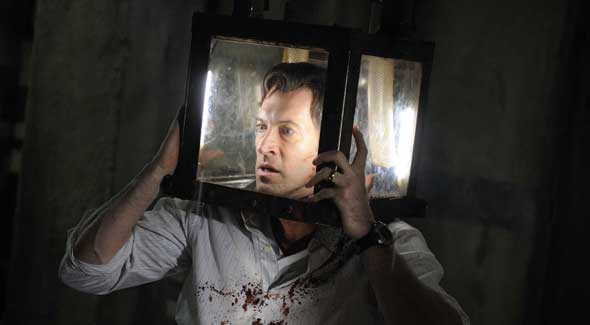
Now you’ve done it – I’m going to be on wikipedia all morning reading about these movies. I saw Saw II, which was enough for me to realize I cannot watch the rest of them, but I love reading the plots. I do remember thinking that Saw II was one of the best horror movies I’d seen. I just can’t handle the torture.
Please tell me this is the start of “Overthinking Saw Week”.
Having only seen the first Saw, Saw III and the first half of Saw IV, I have to say that this article has made me more interested in watching the series from beginning to end than any one of the film’s that I actually have seen. Well done, sir.
From a marketing standpoint, it’s actually kind of brilliant to have a series of films so intricately interwoven. It makes seeing any of the sequels independent of one another nearly incomprehensible, since they’re so story-dependent on one another, that the only real solution is to go out and spend money on Saw I-VI in order to understand what (may or may not have) happened in Saw 3D.
I feel like that’s either a very shrewd business decision, or the result of different teams of filmmakers trying to retcon each other into oblivion just to cover their own asses.
I couldn’t agree more. As a squeamish nerd I love horror but hate the whole wave of “sharp, rusty things being put into people” kind of horror. I watched Saw I because it sounded like that was “the good one”. Then number two because I may as well, I saw it projected onto a nightclub wall before being thrown out for laughing at the headbangers. Then the third because I may as well.
Anyway, as the series went on I watched it more and more for the jenga tower of continuity. I’ve yet to see number six so I’ve got that to do before number seven (killing Luke Danes in number five was a big no-no in my books).
I can’t help but feel that the goal of Jigsaw is doomed to failure, possibly intentionally. As the author mentions, survival and redemption are scarce, if at all possible. The initial plot of the first Saw movie has elements of revenge to it on Jigsaw’s part and perhaps from then was doomed to failure, the moment he wasn’t playing for the logical side of his ‘game’ but for personal reasons, much like Amanda had become more a killer than a ‘gamesmaster’ like her mentor. That led to her punishment, but an impure attitude to his own game possibly led to such a low success rate for Jigsaw’s grand design. Will anyone ever even manage to accomplish it if he gets what looks from the posters like a cult following, or will they fall prey to bloodlust and/or revenge plots?
For someone who couldn’t stand Wolf Creek because of the pointless nature of it, I’m very curious to see what they’ll do with the last film.
Great point. Jigsaw, of course, would claim that none of his games are about revenge. But in the first film, he chooses one victim who attempted suicide, and one victim who’s a junkie. Then he chooses Dr. Gordon, who… cheats on his wife. And HOW does Jigsaw know he’s been cheating on his wife? Because Jigsaw hired a private detective to follow him around. It does really seem like Jigsaw WANTED to put his doctor in a trap, and set out to find a reason for doing so.
I don’t think that Dr. Gordon set up Bobby’s trap, I think that Hoffmann did because Hoffmann knew about Bobby’s game but did not know about Gordon. I think the point of Dr. Gordon taking over was shown when Hoffmann killed Jill Tuck, showing that he let revenge cloud the point of the game. Jigsaw knew this would happen, so then he sent Dr. Gordon to take over for Hoffmann.
You know, I saw the first Saw movie, and I was very impressed by its execution, but almost everyone I knew said that the sequels did not live up to the first one. And I would later find out spoilers from other movies, such as Jigsaw dying at the end of the third film, and I would question how the films could still be any good or at all plausible after that happens.
After reading this article, I’m beginning to think that the Saw series is a lot like the Deathnote manga. Just as complex, but not nearly as supernatural.
Perhaps none of the sequels live up to the first, but after reading this, it seems that comparing the films side-by-side in that way is missing the point. From your writing, it seems like the experience of the entire series is the payoff. Which is really strange, cause the writing and directing team behind the films has changed a few times.
Now I have to watch all these films before Halloween…
There’s another series of movies where the studio logo provides a clue: Indiana Jones. The good ones, Raiders and Crusade, open with the Paramount logo, a mountain, match cutting to a real mountain. I.e., this is the real thing. The less good ones open with the Paramount mountain matching to something that resembles a mountain but isn’t. I.e., these are less than the real thing. In Temple it cuts to simply another image of a mountain (embossed on the silver gong in that Shanghai nightclub). In Crystal Skull they reach the nadir: the match cut is to a gopher mound—literally making mountains into molehills, as it were.
Regarding this whole idea of scaring people to death (literally) in order to make them appreciate life more: From a psychological point of view, it is total nonsense. It is well known that people suffer the worst traumatic experiences when it is other humans who do them harm (rape, assault, torture, acts of war, war crimes etc.). When we have to suffer from illness, accidents or natural disasters, traumatic experiences can indeed have a life-changing effect (if all turns out “well”). But if the suffering is man-made, it is much more likely to lead to feelings of hatred and revenge. The wounded soldier who comes home in high spirits because he now knows to value life more is not even a myth. It simply doesn’t work that way.
I know that Saw “is just a movie”, but in the article, Jigsaw’s “treatment plan” is described uncritically, as if it might actually work. As a psychologist, this bugs me a little bit and I wanted to set the facts straight. Besides this though, I liked the article (even though I don’t like the Saw movies).
Well, ACTUALLY… if you literally scare someone to death, they will be dead. And thus incapable of forming any new views on life.
But I agree with you. The main reason I’ve never watched the Saw movies is that, judging by what I’ve been told about them, the filmmakers endorse (at least tacitly) the belief that Jigsaw forces people to have a greater appreciation for life. That concept ruins my suspension of disbelief because i find it so jarring that it completely takes me out of the movie.
That said, I did very much enjoy the article, and the details of plot intricacies almost made me want to overcome my distaste and watch it. It also helped me to understand what my friends liked about these movies. So thanks for that!
… I guess I should have written “scaring people *with (their)* death …
Perhaps the final peice of the puzzle is that these people have been chosen to endure these ordeals specifically because they couldn’t – rather, they’re the types that would flip out afterwards, and continue on with Jigsaw’s legacy. Seems like that would be a rather twisted ending, all things considered.
Yes youre right, but in the film it is only the super crazy ones that feel vindicated. The final film shows that most of the victims are completely fucked from the experience.
My one problem with this is that Jigsaw consistently cheats with his traps. It happens literally in the opening moments of the first film; a character wakes up, drowning, and thrashes, sucking down the key that would unlock his manacles down the drain as he pulls the plug.
This is pretty consistent in the movies I’ve seen (I, II, and V), and it undercuts the series’ efforts to pass Jigsaw off as anything other than a self-righteous coward who wants to kill people he doesn’t like, but just can’t make himself take that final jump and actually deliberately act. He’s very passive-aggressive, when you think about it.
I’m going to need more specific examples. I’ve thought a lot about the key going down the drain in Saw 1, and I don’t think that’s cheating at all. The trap was for Adam to cut off his own foot to survive. Getting rid of the key is actually a NECESSARY part of this.
I think the movie focusing on the key in that opening shot, and having Jigsaw mention it again at the end, is needlessly confusing.
Don’t get me wrong – I’m open to the possibility that Jigsaw doesn’t play fair after all. I just think that’s not the best example.
I think Jigsaw left the key as a “thank you” for doing what Jigsaw asked of him (taking the pictures if my memory serves)… It’s not Jigsaw’s fault that Adam was clumsy. Besides he had the Saw AND (as I opined before Saw 3) Donnie Wahlberg’s character showed there WERE other ways to get out of that room. :)
I’m not even a big Saw fan but this is very interested, great article.
This article prompted me to start looking at the films wikipedia pages. While scouring over them I came across this little nugget in the intro section for Saw VI:
Following its cinematic release, the film failed to garner any award nominations from mainstream motion picture organizations for its production merits or lead acting.
True that has nothing to do with the films, but that is just way too funny not pass on.
I love the SAW series. I have seen all 7 in order, the last 3-4 in the theater opening weekend. They stimulate my mind the same way that Hannibal Lecter did in the Silence series of movies. Wish they would have done those up better as the SAW creators did. I love the plots, they blow my mind, stimulate every aspect of my intellect, and although I do cover my eyes throughout many parts of each of the last 6 movies, I love them, and truly hope they never stop making this series. I’ll pay my money for a ticket every single year. Jason Vorhes from 13th had 12 movies, and their plot sucked. SAW actually has a great story line, and they’ll successfully pulled of telling a unified story throughout 7 films, surely they can continue a few years more. DON’T STOP, PLEASE!
All Dr. Gordon did was the medical aspects of traps and the last request from John — watch over Jill (and “act immediately” if something were to happen). He wasn’t in with all the kidnappings, etc. Apparently he returned back to work at the hospital since that’s where Jill drops the package off.
Him putting the key behind Michael’s eye in Saw II and everything else had been predicated years ago on forums and YouTube (search Dr. Gordon theories). I can’t believe they actually used it in the film though. I was rather disappointed, mainly because the whole premise and plot of Saw 3D makes no logical sense (even for a Saw film) and fans practically wrote most of the Dr. Gordon scenes. There was no real plot twist or surprise. Just bleh. Saw VI is the real ending of the franchise. :P Nice read.
I’m not buying that all Dr. Gordon did was help Jigsaw out with the medical stuff. You know why? Because he was the one who set up the central game of Saw 3-D. Think about it – Hoffman didn’t kidnap Bobby and rig all those traps. He spent the whole movie trying to find Jill. When the police raid his lair, they find a bunch of monitors showing the POLICE station, not the game that’s currently going on. The Bobby game was ALL Dr. Gordon. I’m sure Jigsaw either designed part of it or all of it – there’s that flashback to when he and Bobby meet at the book signing. But Dr. Gordon was the one who rigged all those traps. (The fact that he KNEW how much weight the pectoral muscles can support is a giveaway.)
I didn’t mind seeing Dr. Gordon revealed as an apprentice, even if it wasn’t the craziest curve ball ever. It was satisfying – a big loose end tied up, the story come full circle. What disappointed me was how little we saw of Dr. Gordon’s relationship with Jigsaw. There’s a lot that’s vague there, and we really need Saw VIII to reveal how Dr. Gordon comes to assist Jigsaw, and what he does next.
Gordon’s two helpers were not identified. The film does not reveal WHY Gordon would help John. I mean it was just minutes before John dragged him off that Gordon was shouting he was going to KILL the man responsible for murdering his family (at the time he thought they had been killed). No mention of his family at all. They could have used another 5 minutes to explain things a bit more. I don’t understand why Lionsgate must need to condensed a complicated film to 90 minutes, especially when parts of Saw 8 was added to Saw 7. There was just more traps and gore than story. The real fans of the Saw films, watch them for the storyline, not guts. Though that is an added bonus.
Anyway, no I don’t believe Gordon did help with the games (we see Hoffman take out a box with Bobby’s game plans, so in the Saw universe that’s what happened, unless it’s proven otherwise in another film). Plus all of the Billy tapes for Bobby, Nina, Suzanne, Cale and Joyce were not by John, it was Hoffman. You can tell by the words Billy uses. One obvious clue was there was no wit added in the tapes and they were just to straightforward. I don’t believe there will be a Saw 8 — at least not in 2011. No closure for John and his work or the films (“all of my work as being leading to this”. To what?). He allowed Jill to die after promising a way out for her. So many more questions brought up than answered, just lazy storytelling. So we’ll have to go with this flat “final chapter”. It was a let down–it really was.
I’d forgotten about Hoffman looking at the photo of Bobby. That’s disappointing, because I really liked the idea that that was all Gordon. Gordon was at Bobby’s meeting. It’s a total coincidence that 5 minutes later HOFFMAN kidnaps him from the parking lot? While he’s busy trying to get Jill?
I’m a little less disappointed about how the movie didn’t explain Dr. Gordon’s relationship with Jigsaw, because these movies have ALWAYS left things unexplained for another movie. Yeah, right now there are no plans for Saw 8. Maybe it’s unlikely we’ll ever see it. But if the writers wanted to keep one thing mysterious, for fans to obsess over, that’s okay with me.
I GUESS it was a let down. I can’t really argue with you. But at the same time, I really enjoyed it – it didn’t feel like a letdown to me. Part of it was that this was the ONLY Saw film I saw in a theater. The rest I caught on DVD. I think being these with an opening weekend crowd made it more fun, and compensated for what probably is, in all fairness, a meh final chapter.
predicted*
Nice analysis.
One quick point….Dr. Gordon didn’t kill Gibson and the police it was Hoffman who set up the machine gun trap and deliberately led them to his lair for that purpose.
I think the other two with Dr Gordon at the end are his wife and son….I noticed one was shorter than the other.
Actually Raj, when I talked about Gordon killing all those cops, I was referring to the poison gas that gets the Swat team. To me, this seemed a little more bloodthirsty than the original Jigsaw. I remember in Saw 2, which is all about a Swat team closing in on Jigsaw. He breaks some shin bones, and he test Eric Matthews, but basically he’s got nothing against the cops.
I really like Jigsaw’s claim in Saw 2 that he never kills anyone, but it gets really hard to defend as the movies progress. Eventually, it’s just impossible to defend.
Well you are speaking like gordon did any of this but i don’t think so :
The big last test in saw 3d was clearly designed by hoffman (wich doesn’t give a fuck about killing since he kills everyone in the police station to get to jill)
Since the background off the place where the test is going is linked to hoffman and gibson, and also when gibson found the “lair” of hoffman where is the body of one of the racists, there are pictures and monitors of the last test, and obviously when you see the reaction of hoffman when he sees gordon he surely didn’t work with him.
Correction : yes mb the screens showed the police station, but i still believe that the pictures showed the test subjects.
However the position of the test is still heavily linked to hoffman ( i don’t exactly remember how but i think the junkie he killed to help gibson was from the place where the test is running or something like that)
However there could be two reasons for hoffman to deliberately give the position of the test while it was still running.
First Giving gordon up.
Or just to have the time to go and kill jill, since a trap was setted up to kill people entering the test i thibk it’s more of a genius plan from hoffman (and since hoffman really doesn’t give a damn about killing anymore i find this story way more credible than gordon turning mass murderer when all the footage we get of him in saw 3d is chirurgical interventions.)
This is great, I really enjoyed reading it. I was wondering if you could elaborate on the last paragraph? “By the way, I need to point something out. Eric Matthews was in the exact same situation Hoffman is in now, and he escaped. Moreover, we can be pretty sure that Hoffman KNOWS how he escaped. So Hoffman isn’t necessarily dead (but if I were a Saw writer, I’d wait a couple more movies before revealing that).”
Eric Matthews got his head squished didn’t he? I’m just a confused Saw fan ha ha.
Amanda locked Eric Matthews in the Bathroom of Doom without a saw. He was out five minutes later, by smashing his foot up. Hoffman would definitely know that, and there’s no reason he couldn’t attempt the same thing.
Hey there. When I was around 14 years old, I watched all seven films. I had PTSD from them. The logic didn’t add up to me. I am 19 today and still feel traumatized by them. Can we get a conversation going about anything related to this?
Also I’m a male.
Dang! Well done.